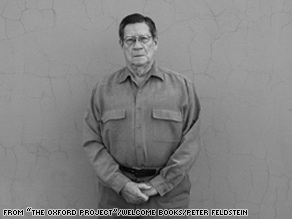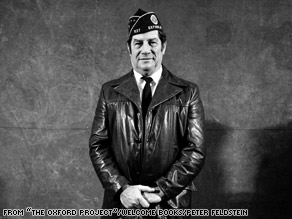

Mr. James Hoyt died Monday at his home in Oxford, Iowa, a town of about 700 people where he had lived his entire life. He was 83.
On April 11, 1945 19 year old private first class James Hoyt and his three comrades -- Capt. Frederic Keffer, Tech. Sgt. Herbert Gottschalk and Sgt. Harry Ward -- found the Nazi concentration/extermination camp Buchenwald in a well-hidden wooded area of eastern Germany. James Hoyt was driving the Jeep, as detailed by CNN.com.
"There were thousands of bodies piled high. I saw hearts that had been taken from live people in medical experiments," Hoyt told author Stephen Bloom in a soon-to-be-published book called "The Oxford Project."
"They said a wife of one of the SS officers -- they called her the Bitch of Buchenwald -- saw a tattoo she liked on the arm of a prisoner, and had the skin made into a lampshade. I saw that."
Capt. Frederick Keffer describes that day
According to military records, Keffer was the officer in command of the six-wheeled armored vehicle that day. The soldiers were part of the Army's 6th Armored Division near the camp when about 15 SS troopers were captured. It was mid-afternoon.
"At the same time, a group of Russians just escaped from the concentration camp, burst out of the woods attempting to attack the SS men. The Russians were restrained and interrogated," Maj. Gen. R.W. Grow, the American commander of the 6th Armored Division, wrote in a 1975 letter about the Buchenwald liberation.
Keffer was ordered to take his three comrades and two of the Russian prisoners "as guides to investigate, report and rejoin as rapidly as possible."
"I took this side journey of about 3 km away from our main force because we kept encountering SS guards and prison inmates, and the latter told us of the large camp to the south," Keffer wrote in a letter around the 30th anniversary of the liberation.
"We had been told by our intelligence that we might overrun a large prison camp, but we -- or at least I -- had no idea of either the gigantic size of the camp or of the full extent of the incredible brutality."
Keffer and Gottschalk, who spoke German, entered the camp through a hole in an electric barbed wire fence. Hoyt and Ward initially stayed at the vehicle.
"We were tumultuously greeted by what I was told were 21,000 men, and what an incredible greeting that was," Keffer wrote. "I was picked up by arms and legs, thrown into the air, caught, thrown again, caught, thrown, etc., until I had to stop it. I was getting dizzy.
"How the men found such a surge of strength in their emaciated condition was one of those bodily wonders in which the spirit sometimes overcomes all weaknesses of the flesh. My, but it was a great day!"
James Hoyt, a Bronze Star recipient and veteran of the Battle of the Bulge, was the last of the four original liberators to die.

2 comments:
The photographs for the Oxford Project are mine and you should have made sure that my name was included since you used my pictures. I realize they're at the bottom of the photographs, but they're barely readable.
Jim was a great guy and a good friend. Everyone who knew him will miss him.
-FUPPETS- condolences on losing Mr. Hoyt. Thanks for the help my man. Best of luck with the book and keep us updated.
Post a Comment